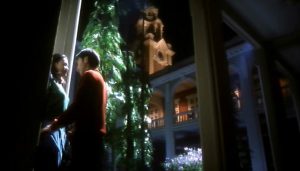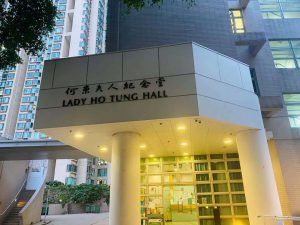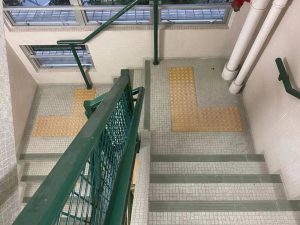CITY OF GLASS, DIR. Mabel Cheung 1998
Lady Ho Tung Hall, 91A Pok Fu Lam Road, Hong Kong
City of Glass (玻璃之城) is a 1998 Hong Kong romance film written and directed by Mabel Cheungand starring Leon Lai, Shu Qi, Nicola Cheung and Daniel Wu. Raphael (Leon Lai) and Vivian (Shu Qi) were both students in the University of Hong Kong in the 1970s, living separately in Lady Ho Tung Hall and Ricci Hall. They fall in love with each other but eventually ended up marrying other people and raising their own families. However, not so long after their reunion in 1990s, they died in a car accident. After their funeral, Raphael’s son and Vivian’s daughter learned of their parents’ affair and embarked on a journey to discover their lives. The most important building in this film may be the Lady Ho Tung Hall, which is the only female dormitory of the University of Hong Kong existing till now.
 In the film, Vivian is playing the ball with her hall mates. Yellow is the symbolic colour of Lady Ho Tung Hall.
In the film, Vivian is playing the ball with her hall mates. Yellow is the symbolic colour of Lady Ho Tung Hall.
 In the film, the Main Building of HKU is the place where Raphael and Vivian first expressed love to each other.
In the film, the Main Building of HKU is the place where Raphael and Vivian first expressed love to each other.
Comparing how the Lady Ho Tung Hall is presented in the film and how it is seen and experienced in reality, I find several interesting differences. First and foremost, as the story was unfolded in the form of memory, everything was in a twilight state. The director was good at using light in the film, for example, the light on the tree behind Raphael and Vivian when they first expressed love to each other, the light around Vivian when she first appeared in the film, and so on. In this way, the film appears to be more imaginative and romantic than reality. What’s more, as the film was finished before the reconstruction of the Lady Ho Tung Hall, many facilities are different between the film and reality. For example, comparing how it is presented in the film and how it is seen and experienced, I feel the building now is more spacious than before, no only the rooms but also the staircases. However, on the ground floor, I think the original one is more spacious, maybe it was because they did not have elevators then.

 In reality, the Lady Ho Tung Hall and its staircases are more spacious than before.
In reality, the Lady Ho Tung Hall and its staircases are more spacious than before.
When it comes to why the Lady Ho Tung Hall is presented these ways in the film, it deserves mentioning the background of this film. The director, Mabel Cheung, was also a student in the University of Hong Kong living in the Lady Ho Tung Hall. When the building was to be reconstruct in 1998, she felt reluctant and made up her mind to direct a film to memorise. Like the name of the film “City of Glass”, she wants to express that many things in the city is like glass, shining but fragile, which only have the brilliance of an instant. Thus in this film, she uses glass for many times, intending to give us a feeling of distance and twilight. People’s faces are behind glass, people’s emotions are in their own hearts. I think this film has a power of silence, which promotes me to look into my heart.
–Song Yang, 3035772781
You have a good knowledge of Lady Ho Tung Hall which allowed you to uncover some of the visual decisions such as costume design and discuss the spatial comparison between the movie and reality. Since you are mostly noting the differences between the two, it would be helpful to include more movie stills and photos to accompany your comparisons. You can even use old photos found online and pair it with your own documentation to visually presents the differences. Regarding the transient quality of the glass metaphor to describe Hong Kong in the movie, you may want to make use of Abbas’ text on disappearance to strengthen your points.